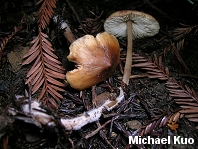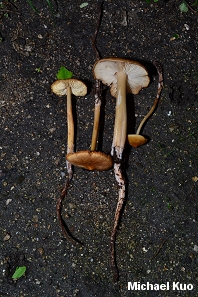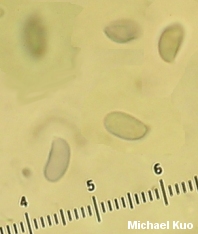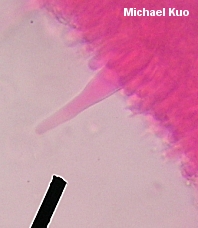| Major Groups > Gilled Mushrooms > Pale-Spored > Collybioid > Caulorhiza umbonata |

|
Caulorhiza umbonata [ Basidiomycetes > Agaricales > Tricholomataceae > Caulorhiza . . . ] by Michael Kuo Like Stropharia ambigua, Caulorhiza umbonata is a "tourist mushroom," thrilling to those of us who live outside of northern California, but thoroughly ho-hum-ish to the natives. I suppose the mushroom itself would get boring after long-term exposure, since its major morphological claim to fame is the presence of a very long "root" extending the stem deep into the substrate, a little like the root of Hymenopellis furfuracea--an eastern mushroom whose radicating stem, I admit, ceased thrilling me many years ago. The substrate for Caulorhiza umbonata, however, is the humus and soil under redwoods, and how anyone could get bored with hunting mushrooms under redwoods is a mystery to me. No less a life-long naturalist than Richard Dawkins, for example, writes in The Ancestor's Tale (2004, p. 514): "People argue about the one place in the world that you must visit before you die. My candidate is Muir Woods, just north of the Golden Gate Bridge. . . . It is a cathedral of greens and browns and stillness, the nave lofted by the world's tallest trees." And, if you are there in fall or winter, the floor of the cathedral will feature Caulorhiza umbonata--which, incidentally, you may not pick at Muir Woods; visit nearby Salt Point State Park if you want to pick mushrooms. Mycologist Tom Volk (2004) points out that Caulorhiza umbonata serves as a reliable indicator of the presence of redwood trees, which are often elusive and hard to see. Collybia umbonata is a former name. Thanks to Wendell Wood for collecting, documenting, and preserving Caulorhiza umbonata for study; his collection is deposited in The Herbarium of Michael Kuo. Description: Ecology: Presumed to be saprobic on decaying debris under redwoods; growing alone, scattered, or gregariously; fall and winter; throughout the range of Sequoia sempervirens. Cap: 3-17 cm; conical or bell-shaped when young, becoming broadly bell-shaped and typically retaining a central bump or point; dry or a little sticky; smooth; dark brown to reddish brown, fading to tan or yellowish brown. Gills: Attached to the stem, often by means of a notch--or nearly free from the stem in maturity; close; whitish, sometimes discoloring yellowish to pinkish or brownish. Stem: 5-15 cm long above ground, with an additional 30 cm or more below ground; up to about 1.5 cm thick at the widest portion; typically tapering to apex, and with the "root" gradually tapered; dry; smooth; tough; often twisted; whitish or dirty yellowish or tan. Flesh: Whitish, thin. Odor & Taste: Not distinctive. Spore Print: White. Microscopic Features: Spores 5-8 x 3-5 µ; elliptical; smooth; amyloid. Pleuro- and cheilocystidia abundant; 55-90 x 9-15 µ; fusoid to fusoid-ventricose, occasionally with swollen areas; thin-walled. Pileipellis a thin cutis of narrow elements above a cellular-like layer of inflated elements; hyaline to brown in KOH. REFERENCES: (Peck, 1904) Lennox, 1979. (Smith, Smith & Weber, 1979; Arora, 1986; Lincoff, 1992; Kuo & Methven, 2010.) Herb. Kuo 01150511, 01050701, 01161301. This site contains no information about the edibility or toxicity of mushrooms. |
© MushroomExpert.Com |
|
Cite this page as: Kuo, M. (2013, January). Caulorhiza umbonata. Retrieved from the MushroomExpert.Com Web site: http://www.mushroomexpert.com/caulorhiza_umbonata.html |



